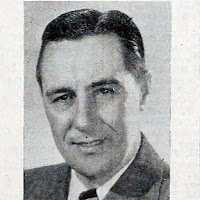 |
| Kevin McCarthy, Gage Clarke, "Nightmare" (1956). |
He Murders as He Sleeps!
Contains spoilers
By Paul Parcellin
When it comes to crafting stories of dread and entrapment, Cornell Woolrich stands out among his peers. His darkest work seethes with feverish, paranoid fantasies. Wrongly accused men, caged on death row or free and living under a stifling cloud of suspicion, are driven to prove their innocence. Visions of the noose, electric chair or gas chamber press on them. As clocks run down, hope of salvation evaporates like dew in afternoon sunlight.
 |
| Cornell Woolrich |
His novels and short stories were adapted into nearly 30 feature films, including Alfred Hitchcock’s “Rear Window” (1954), based on the 1947 Woolrich story “It Had to Be Murder,” and François Truffaut’s “The Bride Wore Black” (1968), based on the 1940 novel of the same title, credited to William Irish (a pseudonym of Woolrich).
In Woolrich’s universe, the accused may or may not be guilty — at times, they themselves are unsure. Their minds may be clouded by narcotics and alcohol, their memories distorted by hypnotic suggestion. Tortured by thoughts of heinous acts they may have committed, protagonists find dark relief from their torments in theC prospect of a quick demise, be it by execution or suicide.
The suffocating claustrophobia of “Nightmare,” a novel by Woolrich as William Irish, is one such story. Adapted at least twice for the screen, “Fear in the Night” (1947) and “Nightmare” (1956), both directed by Maxwell Shane. The two films offer a Kafkaesque marriage of horror and the absurd. Improbable, fraught with coincidences and at times just plain weird, Woolrich’s tall tales resemble the disjointed reality of nightmares. Yet the stifling predicaments and persecution fantasies of Woolrich’s characters are as captivating as they are unsettling.
 |
| DeForest Kelley, "Fear in the Night" (1946). |
In “Nightmare,” Clarinetist Stan Grayson (Kevin McCarthy) dreams he killed a man, then awakens to find evidence linking him to his imagined crime. His brother-in-law, New Orleans police detective Rene Bressard (Edward G. Robinson) is skeptical of Stan's story.
A strange looking door key, a button from a jacket or shirt and blood stains on Grayson’s clothes and person are the tantalizing clues he discovers after a night’s slumber. At first he believes that the button, key and blood materialized out of his dream. But in the light of day, the physical evidence that links him to a real murder is undeniable.
As the story dips into the irrational, we feel the protagonist’s growing terror as he begins to sense he’s losing his grip on sanity. In this strange and unpredictable world in which he finds himself, he and Bressard discover that the true perpetrator behind the crime, not fate, has set a perfect trap for him.
 |
| McCarthy, Edward G. Robinson, "Nightmare." |
As pieces to the puzzle begin to come together we learn that hypnosis was the motivating force behind the crime. How the fall guy lands in so much trouble is more complex and difficult to swallow. Let’s just say that conspiracy plus coincidences play important roles in the story.
Woolrich’s plots often stretch credulity to the breaking point, and another filmic adaptation of his story, “Phantom Lady” (1944), comes to mind — any number of others would be apt examples of Woolrich’s offbeat story plots, as well. Similar to “Nightmare” and “Fear in the Night” for its strange and uncanny events, the “Phantom Lady” storyline has an eerie similarity to the subconscious nocturnal wanderings of an unquiet mind. The plot involves a man falsely convicted of murder, and his loyal secretary’s obsessive search to find the woman who can back up the alleged killer’s alibi — a recurring theme in Woolrich’s work.
 |
| Fay Helm, Alan Curtis, "Phantom Lady" (1944). |
For the most part, Woolrich’s characters are realistic, ordinary folks, even if the stories that bring them to life display a reckless disregard for plausibility. While the stories may be fantastical, they seldom delve into abstract symbolism — well, not much, anyway. The mirrored room, for instance, is pretty trippy. Instead, we get a mostly straightforward, linear narrative whose weird coincidences might be more disturbing if the story wasn’t so entertaining.
You could say that Woolrich’s flights of fancy show a gutsy handling of the medium by a master at the top of his game. But it’s also notable that his literary output was fairly enormous. He was a writing machine who cranked out numerous novels, short stories and other texts. So, perhaps some of the stranger coincidences, creaky plot turns and major implausibilities were the byproduct of a writer working at a furious pace and hounded by deadlines. Sometimes, ready or not, you just have to get the thing out to the editor.
Some might say that his work is flawed. But more rational, buttoned-down plots surely wouldn’t be as fun and entertaining as these. His work is pulp fiction that invites us to suspend disbelief as we climb aboard an uncoupled train car speeding downhill toward a perilous turn at the edge of a cliff.
Woolrich wrote about outsiders grappling with insurmountable problems and impossible odds, and likewise his solitary life was marked by tragedy and hardship. After his mother's passing in his mid-50s, he struggled with diabetes and alcoholism. His health continued to decline, and he eventually lost a leg to gangrene. His life was cut short when he died of a stroke at the age of 64 in 1968.
As for “Fear in the Night” and “Nightmare,” both made by budget-conscious Pine-Thomas Productions, Paramount’s B-picture division, DeForest Kelley’s restrained performance in “Fear in the Night” is stronger than that of Kevin McCarthy, who is more on the histrionically cranky side in “Nightmare.” Edward G. Robinson turns in a reliably solid performance in the latter, however, and both films are well worth your viewing time.





